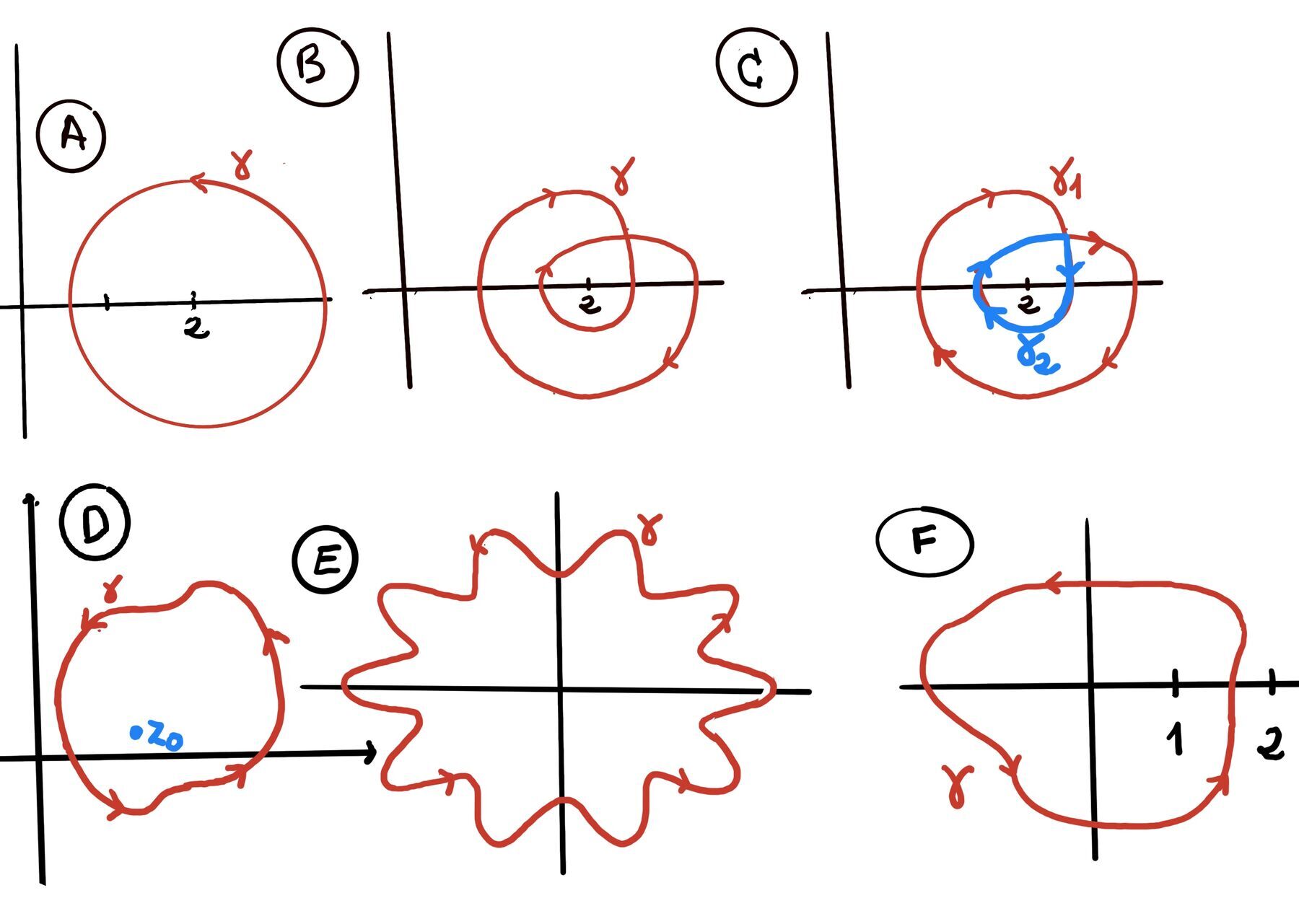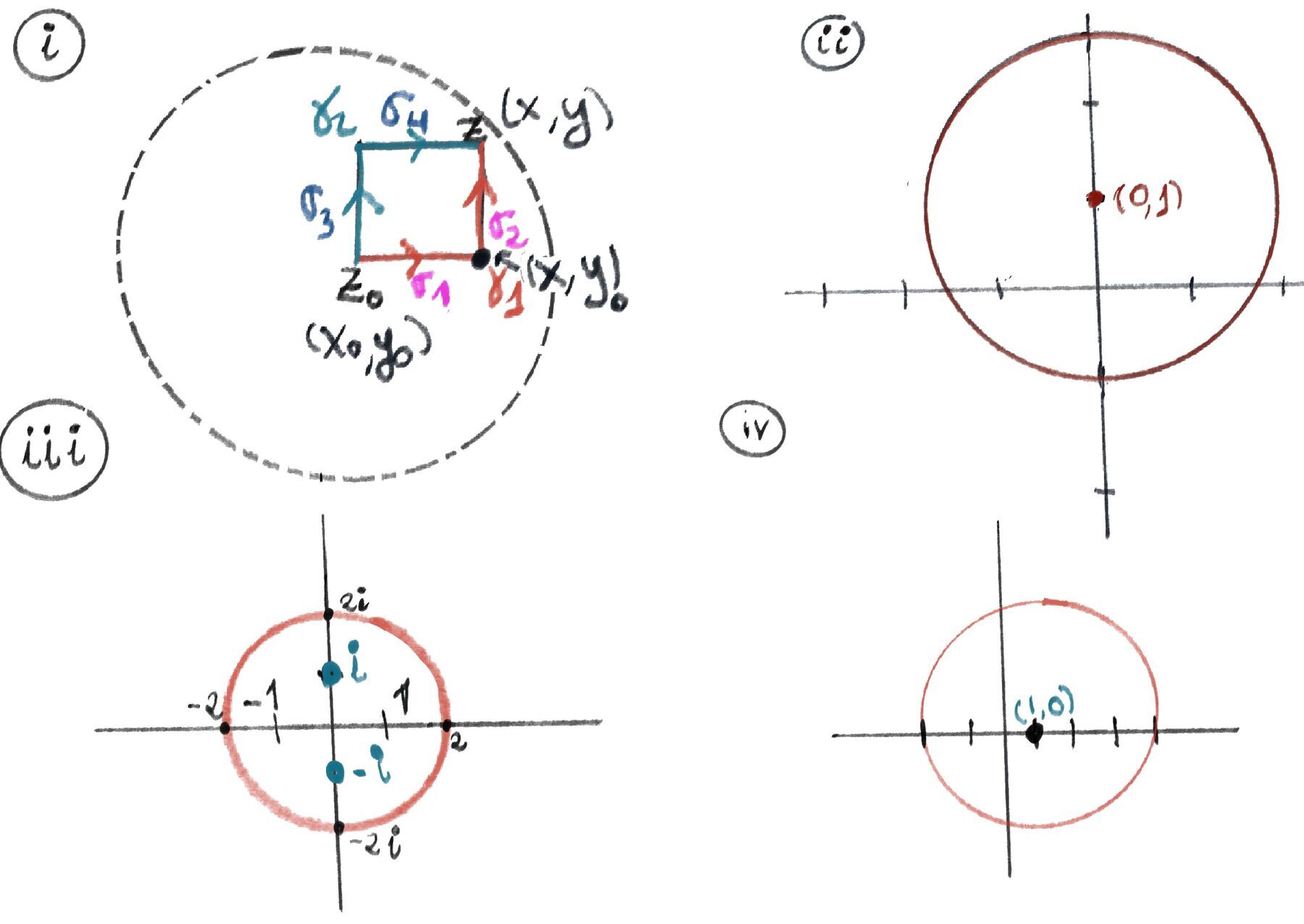
|
 |
 |
Sometimes people don’t want to hear the truth because they don’t want their illusions destroyed, Friedrich Nietzsche.

A complex function $f(z)$ maps $z = x + iy \in \mathbb{C}$ to another complex number. For example: $f(z) = z^2 = (x + iy)^2 = x^2 - y^2 + 2ixy, f(z) = \frac{1}{z}, f(z) = \sqrt{z^2 + 7}$.
A contour is a continuous, piecewise-smooth curve defined parametrically as: $z(t) = x(t) + iy(t), \quad a \leq t \leq b$.
Definition (Smooth Contour Integral). Let ᵞ be a smooth contour (a continuously differentiable path in the complex plane), $\gamma: [a, b] \to \mathbb{C}$. Let $f: \gamma^* \to \mathbb{C}$ be a continuous complex-valued function defined on the trace $\gamma^*$ of the contour (i.e. along the image of $\gamma$). Then, the contour integral of f along $\gamma$ is defined as $\int_{\gamma} f(z)dz := \int_{a}^{b} f(\gamma(t)) \gamma^{'}(t)dt$.

Deformation of Contours. If two contours $\gamma_1$ and $\gamma_2 $ are homotopic (i.e., one can be continuously deformed into the other without crossing any singularities of f) in a domain where f(z) is analytic, then: $\int_{\gamma_1} f(z)dz = \int_{\gamma_2} f(z)dz.$
Fundamental Theorem of Calculus for Contours. Suppose $\gamma$ is a contour (piecewise smooth path) from a to b, f is defined on a domain D containing $\gamma^*$ (the image of $\gamma$) and admits a primitive (antiderivative) F on D (i.e., $F'(z) = f(z)$), then $\int_{\gamma} f(z)dz = F(\gamma(b)) - F(\gamma(a))$. In particular, if $\gamma$ is a closed contour (i.e., $\gamma(a)=\gamma(b)$), this integral evaluates to zero, $\int_{\gamma} f(z)dz = 0.$
Estimation Theorem or the Triangle Inequality for Integrals. The triangle inequality for integrals in complex analysis states thatfor any continuous complex function $f:[a,b] \to \mathbb{C}$ on a closed real interval [a,b] (f(t) = u(t) + iv(t), t a real parameter), the following holds: $∣\int_a^b f(t)dt| \leq \int_a^b |f(t)|dt$.
Estimation Lemma (ML Inequality) for contour integrals. For any continuous complex function $f:[a,b] \to \mathbb{C}$ on a closed real interval [a,b] (f(z) = u(x, y) + iv(x, y)) with f bounded by some constant M along the entire contour, |f(z)| ≤ M for all $z \in \gamma^*$ (the image/trace of the contour in the complex plane), the following holds: $∣\int_\gamma f(z)dz| \leq M \cdot l(\gamma)$ where l(γ) is the arc length of the contour γ given by $\int_a^b |\gamma^{'}(t)|dt = \int_a^b \sqrt{x'(t)^2 + y'(t)^2} \text{ where } \gamma(t) = x(t) + iy(t)$.
Jordan’s curve theorem. Any simple closed curve (a continuous loop in the plane that does not intersect itself) separates the plane into two disjoint connected regions: one interior (bounded) and one exterior (unbounded). The curve itself is the boundary of both regions. In other words, it partitions the plane into exactly three disjoint sets:
Cauchy’s theorem (Classical “Green’s theorem” version). Let $\Omega \subset \mathbb{C}$ be an open domain. Suppose f = u + iv is analytic in $\Omega$ and its partial derivatives ( $u_x,u_y,v_x,v_y$) are continuous in $\Omega$. If $\gamma$ is a positively oriented, piecewise-smooth $C^1$, simple closed contour with $\gamma^* \cup \operatorname{Int}(\gamma) \subset \Omega$ (its path and interior both lie inside Ω), then $\oint_{\gamma} f(z)dz = 0.$
Cauchy’s Theorem (Cauchy–Goursat). This is the more powerful version, as it removes the need for continuous partial derivatives. If f is analytic in an open set containing a simple closed contour γ and its interior $\gamma^*\cup\operatorname{Int}(\gamma)$, then $\oint_{\gamma} f(z)dz = 0$.
Cauchy’s Theorem for simply connected domains. If a function f is analytic (a function that is complex-differentiable at every point within a domain, i.e., well-behaved and smooth, with no sharp corners, breaks, or singularities like division by zero) throughout a simply simple connected domain D then $\oint_C f(z)dz = 0$ for every closed contour C lying in D.
General Cauchy Theorem for Multiply Connected Domains. Let $R$ be the multiply connected region (with n holes) inside $C$ but outside of every $C_k$ (each $C_k$ surrounds only one hole in the domain), $R = Int(C) \setminus \bigcup_{k=1}^n \overline{Int(C_k)}$, and let $f(z)$ be analytic on $R$. Now, let $\Gamma$ be any general closed contour (not necessarily simple) that lies entirely in R. This $\Gamma$ can wind around the “holes” (the regions inside each $C_k$) in any way it likes (this is the winding number or index of $\Gamma$ around each hole), the integral over $\Gamma$ is: $\oint_{\Gamma} f(z)dz = \sum_{k=1}^n m_k \oint_{C_k} f(z)dz$.
The Anti-Derivative Theorem. Let f be a continuous function on a region G (a region is an open, connected set). Then, the following statements are equivalent:
Cauchy’s Theorem for a disk. If a function f(z) is analytic in an open disk $D = B(z_0; \delta)$ (a disk centered at $z_0$ with radius $\delta$), then the contour integral for any closed contour γ lying entirely in $B(z_0; \delta)$ is zero, $\oint_{\gamma} f(z)dz = 0.$
It’s the key step that generalizes Cauchy’s theorem from a specific shape (like a rectangle) to any loop within a “safe” region (a disk).
Proof.
Let z = (x, y) be an arbitrary point in the disk $B(z_0; \delta), z_0 = (x_0, y_0)$. We could construct a rectangle inside the disk. We denote γ₁ the L-shaped anti-clockwise path from z to z₀ consisting of a horizontal line segment (σ₁ go from $z_0 = (x_0, y_0) \text{ to } (x, y_0)$) followed by a vertical segment (σ₂ go from $(x, y_0) \text{ to } z = (x, y)$) and γ₂ the L-shaped clockwise path from z to z₀ consisting of a vertical line segment (σ₃ go from $z_0 = (x_0, y_0) \text{ to } (x_0, y)$) followed by a horizontal segment (σ₄ go from $(x_0, y) \text{ to } z = (x, y)$) (Figure i).

γ₁-γ₂ is the boundary of a rectangular region. So by Cauchy’s Theorem for a rectangle, which states that $\oint_R f(z)dz = 0$ for any closed rectangle $R$ whose interior is also in $D$, $\oint_{\gamma_1 - \gamma_2}f(z)dz = 0 \leadsto[\text{ Linearity of contour integrals}] \oint_{\gamma_1} f(z)dz = \oint_{\gamma_2} f(z)dz$.
The proof’s goal is to show that $f(z)$ has an antiderivative $F(z)$ (a function where $F'(z) = f(z)$) everywhere inside the disk $D$. We will define our potential antiderivative $F(z)$ as an integral from $z_0$ to $z, F(z) = \int_{z_0}^z f(\xi)d\xi$. Our function $F(z)$ is well-defined. It doesn’t matter if we use the H-V path ($\gamma_1$) or the V-H path ($\gamma_2$); the value of $F(z)$ is the same.
$F(z) = \int_{z_0}^z f(\xi)d\xi = \oint_{\gamma_1} f(ξ)dξ = \oint_{\gamma_1} f(ξ)dξ \text{ for } z \in B(z_0; \delta)$.
We will show $F(z)$ is analytic by showing it satisfies the Cauchy-Riemann (C-R) equations and has continuous partials. The C-R equations for $F$ are $U_x = V_y$ and $U_y = -V_x$.
Calculating $\frac{\partial F}{\partial x}$. To find the partial derivative with respect to $x$, it’s easiest to use the V-H path ($\gamma_2$) expression, because the variable $x$ only appears in the second integral (x is the upper limit).
$$ \begin{aligned} F(z) = \oint_{\gamma_2} f(ξ)dξ &=\oint_{\sigma_3} f(ξ)dξ + \oint_{\sigma_4} f(ξ)dξ \\[2pt] &\text{Let's parameterize it:} \\[2pt] &=\int_{t=y_0}^y f(x_0 + it)\cdot 1 \cdot i \cdot dt + \int_{t=x_0}^x f(t + iy)\cdot i \cdot dt. \end{aligned} $$Now, differentiate with respect to $x, \frac{\partial F}{\partial x} = 0 + \frac{\partial}{\partial x} \left[ \int_{x_0}^x f(t+iy) dt \right]$
By the Fundamental Theorem of Calculus (for real variables), the derivative of an integral with respect to its upper limit is just the integrand evaluated at that limit, $\frac{\partial F}{\partial x} = f(x+iy) = f(z)$
First Fundamental Theorem of Calculus. Let f be a real-valued function that is continuous on an interval [a, b]. Define a function F by $F(x) = \int_a^x f(t)dt$ for $x \in [a, b]$. Then, F is differentiable on (a, b), and F’(x) = f(x). In other words, the derivative of the integral from a to x of f(t) is just f(x).
Calculating, $\frac{\partial F}{\partial y}$. To find the partial derivative with respect to $y$, it’s easiest to use the H-V path ($\gamma_1$) expression.
$$ \begin{aligned} F(z) = \oint_{\gamma_1} f(ξ)dξ &=\oint_{\sigma_1} f(ξ)dξ + \oint_{\sigma_2} f(ξ)dξ \\[2pt] &\text{Let's parameterize it:} \\[2pt] &=\int_{t=x_0}^x f(t+iy_0)\cdot 1 \cdot dt + \int_{t=y_0}^y f(x+it)\cdot i \cdot dt. \end{aligned} $$Now, differentiate with respect to $y, \frac{\partial F}{\partial y} = 0 + \frac{\partial}{\partial y} \left[ \int_{y_0}^y f(x+it) i dt \right]$
By the Fundamental Theorem of Calculus again: $\frac{\partial F}{\partial y} = f(x+iy) \cdot i = i f(z)$
We have found the partial derivatives of $F(z), \frac{\partial F}{\partial x} = f(z), \frac{\partial F}{\partial y} = i f(z)$. From this, we can see that $\frac{\partial F}{\partial y} = i \frac{\partial F}{\partial x}$, which is a compact form of the C-R equations.
Let’s check explicitly: Let F = U + iV, f = u + iv, and we know $\frac{\partial F}{\partial x} = f(z), \frac{\partial F}{\partial x} = U_x + iV_x = u + iv \implies U_x = u, V_x = v$
$\frac{\partial F}{\partial y} = i f(z), \frac{\partial F}{\partial y} = U_y + iV_y = i(u+iv) = -v + iu \implies U_y = -v, V_y = u$
Check C-R: $U_x = u$ and $V_y = u \implies U_x = V_y, U_y = -v$ and $V_x = v \implies U_y = -V_x$.
The partials of $F$ (which are $u, v, -v, u$) are continuous because $f=u+iv$ is analytic, and analytic functions are continuous.
Conclusion: $F(z)$ satisfies the C-R equations and has continuous partials, so $F(z)$ is analytic in the disk $D$ and F’(z) = f(z).
For any analytic function $F(z)$, its complex derivative $F'(z)$ is always equal to its partial derivative with respect to $x, F'(z) = \frac{\partial F}{\partial x}$
The derivative $F'(z)$ is defined by the limit:$F'(z) = \lim_{\Delta z \to 0} \frac{F(z + \Delta z) - F(z)}{\Delta z}$.
For $F(z)$ to be analytic, this limit must be the same no matter which direction or path $\Delta z$ takes as it approaches 0.
Choosing a Convenient Path (The Horizontal Path). Let’s choose the simplest possible path for $\Delta z \to 0$: a horizontal one. This means $\Delta z$ is a purely real number, so we can write $\Delta z = \Delta x$. Plugging this into the limit definition: $F'(z) = \lim_{\Delta x \to 0} \frac{F(z + \Delta x) - F(z)}{\Delta x}$
This is exactly the definition of the partial derivative $\frac{\partial F}{\partial x}$ and we have successfully calculated this exact partial derivative: $\frac{\partial F}{\partial x} = f(z)$.
Thus, f has an antiderivative throughout the disk $B(z_0; \delta)$. By the antiderivative theorem (1)⇒(2), the integral of $f$ over any closed contour $\gamma$ in $D$ must be zero, $\oint_{\gamma} f(z)dz = 0$.
Entire function, any disk. Let f(z) = $e^{z^3}$, γ : |z–1| = 5. Since f(z) is an entire function (analytic everywhere in $\mathbb{C}$), it is certainly analytic on and inside the circle $\gamma: |z-1|=5.$ By Cauchy’s theorem for a disk [$\oint_γ f(z) dz = 0$ provided f is analytic in the whole open disk that carries γ.], $\oint_{\gamma} e^{z^3}dz = 0$.
$e^z$ is entire, and since the composition of entire functions is entire, $e^{z^3}$ is also entire. This means $f(z) = e^{z^3}$ has no singularities anywhere in \mathbb{C}.
Any entire function will behave exactly like the previous example $f(z)=e^{z^3}$: the contour integral around any circle vanishes by Cauchy’s theorem for a disk, since there are no singularities anywhere in $\mathbb{C}$, e.g., $e^z; e^{z^n}; \sin(z); \cos(z); \sin(z^2); \cos(e^z); e^{\sin(z)}; P(z)$ where P is any polynomial and $n \in \mathbb{N}$.
Polynomial, any disk. Polynomials are entire, so $f(z)=z^4-3z+7$ is analytic everywhere. Circle: $\gamma$: |z+2i|=0.3 is a closed curve contained in the domain of analyticity. By Cauchy’s theorem for a disk [$\oint_γ f(z) dz = 0$ provided f is analytic in the whole open disk that carries γ.], $\oint_{\gamma} z^4-3z+7 dz = 0$.
If you like, you can also see it via an antiderivative $F(z)=\frac{z^5}{5}-\frac{3}{2}z^2+7z;$ the integral of F’ over any closed curve is zero.
Rational function whose poles miss the disk. The function $f(z)=\frac{1}{z²+ 9} =\frac{1}{(z-3i)(z+3i)}$ has simple poles at $z = \pm 3i$. The circle $\gamma: |z-1|=2$ is centered at 1 and has radius 2. Hence, both poles lie outside the disk $\mathbf{B}(1; 2)$. Since the disk avoids the poles, f is analytic on and inside $\gamma$. By Cauchy’s theorem for a disk [$\oint_γ f(z) dz = 0$ provided f is analytic in the whole open disk that carries γ.], $\oint_{\gamma} \frac{1}{z^2+9} dz = 0$.
Composition with entire function The function f(z) = cos(sin(z)) is an entire function (sin(z) and cos(w) are entire, and the composition of entire functions is entire; hence f(z) = cos(sin(z)) is entire, analytic everywhere in ℂ), it is certainly analytic on and inside the circle, γ: |z| = 12. By Cauchy’s theorem for a disk [$\oint_γ f(z) dz = 0$ provided f is analytic in the whole open disk that carries γ.], $\oint_{\gamma} cos(sin(z)) dz = 0$.
Log branch inside a disk avoiding the cut. The principal logarithm Log is analytic on $\mathbb{C}\setminus(-\infty,0]$. For $f(z)=\mathrm{Log}(z+4)$, the excluded set is shifted to the ray $(-\infty,-4]$. $\gamma$: |z| = 1 bounds the disk $\mathbf{B}(0; 1)$. This disk does not intersect the ray $(-\infty,-4]$, since all points in $\mathbf{B}(0; 1)$ have real part greater than -1. Because z + 4 never falls on the principal cut $(-\infty,-4]$ for $z\in \mathbf{B}(0; 1)$, f is analytic on and inside $\gamma$. By Cauchy’s theorem for a disk [$\oint_γ f(z) dz = 0$ provided f is analytic in the whole open disk that carries γ.], $\oint_{\gamma} \mathrm{Log}(z+4) dz = 0$.
Integral with enclosed poles and residue cancellation. $f(z) = \frac{1}{z²+1}, \gamma: |z| = 2$. Cauchy’s theorem for a disk doesn’t apply because $f(z)=\frac{1}{z^2+1}$ is not analytic on B(0; 2) (it has poles at $z = \pm i$ inside) (Figure iii).

For a simple pole at a point $z_k$ (i.e., the denominator has a simple root) is calculated using the formula $Res(f, z_k) = \lim_{z \to z_k}(z-z_k)f(z)$.
$\text{Res}\left(\frac{1}{z^2+1}, i\right) = \lim_{z \to i}(z-i)\frac{1}{z^2+1} = \lim_{z \to i} \frac{1}{z+i} = \frac{1}{2i}$
$\text{Res}\left(\frac{1}{z^2+1}, -i\right) = \lim_{z \to -i}(z+i)\frac{1}{z^2+1} = \lim_{z \to -i} \frac{1}{z-i} = \frac{1}{-2i}.$
The Residue Theorem states that the integral of a function f(z) around a simple (doesn’t cross itself), and positively oriented (counter-clockwise) contour γ is equal to 2πi times the sum of the residues of all singularities inside the contour: $\oint_{|z|=2}\frac{dz}{z^2+1} = 2\pi i \sum Res(f, z_k) = 2\pi i\left(\frac{1}{2i}+\frac{1}{-2i}\right) = 0,$ so the contour encloses both simple poles with opposite residues, yielding cancellation.
The curve C is the circle centered at i (0, 1) with radius 2 (Figure ii). We know that $a^2 - b^2 = (a + b)(a - b)$. Then, we have $\frac{1}{z^2 + 4} = \frac{1}{z^2 - (2i)^2} = \frac{1}{(z + 2i)(z - 2i)}$.

F(z) is not analytic at z = ±2i and 2i lies inside the circle, so we cannot apply the Cauchy’s Theorem for a disk.
Cauchy Integral Formula. If a function f is analytic in a simply connected domain D and γ is a simply closed contour (positive orientated) in D. Then, for any point $z_0$ inside γ we have $f(z_0) = \frac{1}{2\pi i}\cdot \int_{\gamma} \frac{f(z)}{z-z_0}dz$
$F(z) = \frac{1}{(z + 2i)(z - 2i)} = \frac{\frac{1}{z+2i}}{z-2i} = \frac{f(z)}{z -2i} \text{ where we define } f(z) = \frac{1}{z+2i}$.
Clearly, f(z) is analytic inside and on the closed curve C (only z = 2i lies inside C). By Cauchy’s Integral Formula, $\oint_C \frac{1}{z^2 + 4} = 2\pi i f(2i) = 2\pi i \cdot \frac{1}{4i} = \frac{\pi}{2}$
C is a circle with center (1, 0) and radius 3. $\frac{e^{2z}}{(z+1)^4}$ is not analytic at z = -1 because this singularity lies inside the circle C (Figure iv).

Let f(z) = $e^{2z}$, f is analytic inside and on the circle C. Then, by the extension of Cauchy’s Integral Formula, $\int_{\gamma} \frac{f(z)}{z-z_0}dz = 2\pi i \cdot f(z_0), \int_{\gamma} \frac{f(z)}{(z-z_0)^{(n+1)}}dz = \frac{2\pi i}{n!} \cdot f^{(n)}(z_0)$ where f(z) = $e^{2z}, n = 3, z_0 = -1$.
$\frac{e^{2z}}{(z+1)^4} = \frac{f(z)}{(z+1)^4} = \frac{2\pi i}{3!}f^{(3)}(-1) = \frac{2\pi i}{3\cdot 2}\frac{8}{e^2} = \frac{8\pi i}{3e^2}$
$f'(z) = 2e^{2z}, f''(z) = 4e^{2z}, f'''(z) = 8e^{2z}, f'''(-2) = 8e^{-2}=\frac{8}{e^2}$